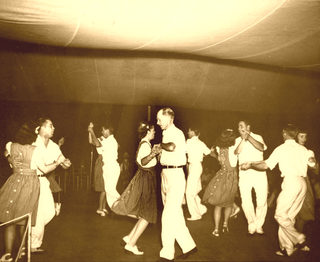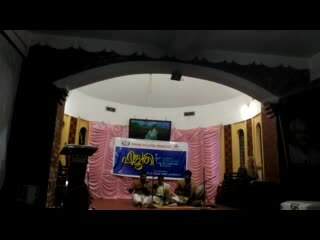
The performing arts are arts such as music, dance, and drama which are performed for an audience. It is different from visual arts, which is when artists use paint, canvas or various materials to create physical or static art objects. Performing arts include a range of disciplines which are performed in front of a live audience, including theatre, music, and dance.

A square dance is a dance for four couples arranged in a square, with one couple on each side, facing the middle of the square. Square dances contain elements from numerous traditional dances and were first documented in 16th-century England, but they were also quite common in France and throughout Europe. Early square dances, particularly English country dances and French quadrilles, traveled to North America with the European settlers and developed significantly there.

Gamelan is the traditional ensemble music of the Javanese, Sundanese, and Balinese peoples of Indonesia, made up predominantly of percussive instruments. The most common instruments used are metallophones played by mallets and a set of hand-played drums called kendhang which register the beat. The kemanak and gangsa are commonly used gamelan instruments in Java. Other instruments include xylophones, bamboo flutes, a bowed instrument called a rebab, siter, and vocalists named sindhen (Female) or gerong (Male).

Obon (お盆) or just Bon (盆) is a Japanese Buddhist custom to honor the spirits of one's ancestors. This Buddhist–Confucian custom has evolved into a family reunion holiday during which people return to ancestral family places and visit and clean their ancestors' graves when the spirits of ancestors are supposed to revisit the household altars. It has been celebrated in Japan for more than 500 years and traditionally includes a dance, known as Bon Odori.
Brunei is a southeast Asian country located on Borneo between the states of Sabah and Sarawak which are part of Malaysia. There is a wide array of native folk music, and dance. Brunei shares some Cultural perspectives and links with the countries of South East Asia such as Malaysia, Singapore, Indonesia, Thailand, Philippines. The strong Islamic influence means that dance performances and music are somewhat restricted.

Garba is a form of dance which originates from the state of Gujarat in India. The name is derived from the Sanskrit term Garbha ("womb") and Deep. Many traditional garbas are performed around centrally lit lamp or a picture or statue of the Goddess Shakti. Traditionally, it is performed during the nine-day Hindu festival Navarātrī. Either the lamp or an image of the Goddess, Durga is placed in middle of concentric rings as an object of veneration.
The traditional culture of Samoa is a communal way of life based on Fa'a Samoa, the unique socio-political culture. In Samoan culture, most activities are done together. The traditional living quarters, or fale (houses), contain no walls and up to 20 people may sleep on the ground in the same fale. During the day, the fale is used for chatting and relaxing. One's family is viewed as an integral part of a person's life. The aiga or extended family lives and works together. Elders in the family are greatly respected and hold the highest status, and this may be seen at a traditional Sunday umu.

Turkish folk dances are the folk dances of Turkey. Facing three seas, straddling important trade routes, Turkey has a complex, sophisticated culture, reflected in the variety of its dances. The dominant dance forms are types of line dance. There are many different types of folk dances performed in various ways in Turkey, and these reflect the cultural structure of each region. The Bar in Erzurum province, the Halay in the East and Southeast, the Hora in Thrace, the Horon in the Black Sea, Spoon dances in and around Konya and Lezginka in Kars and Ardahan are the best known examples of these.

Sitara Devi was an eminent Indian dancer of the classical Kathak style of dancing, a singer, and an actress. She was the recipient of several awards and accolades, and performed at several prestigious venues in India and abroad, including at the Royal Albert Hall, London (1967) and at the Carnegie Hall, New York (1976).

Prabhu Deva is an Indian dance choreographer, film director, producer and actor who has worked predominantly in Tamil, Hindi, and Telugu language films. In a career spanning 32 years, he has performed and designed a wide range of dancing styles and has garnered two National Film Awards for Best Choreography. In 2019, he was awarded the Padma Shri for his contributions to dance.
Planet Sketch is a British-Canadian animated television series produced by Aardman Animations and Decode Entertainment. The show first aired on CITV from September 10, 2005, and later began airing on Teletoon starting on November 19, 2005. The series ended its run on September 16, 2008 with the episode "Hide and Seek".

Pasodoble is a fast-paced Spanish military march used by infantry troops. Its speed allowed troops to give 120 steps per minute. This march gave rise to a traditional Spanish dance, a musical genre including both voice and instruments, and a genre of instrumental music often played during bullfight. Both the dance and the non martial compositions are also called pasodoble.

Pulluvan Pattu is a form of serpent worship performed by both the lower castes and higher castes, in addition to serpent temples. The pulluvar of Kerala are closely connected to serpents. They consider the snake gods their presiding deities and perform sacrifices and sing songs.
The Mapalé is an Afro-Colombian style of dance that was brought over by the slaves, and representing the fishermen after a long day of work. Its name comes from the Cathorops mapale (fish) when they are out of the water. The dance moves are compared with the agility and strength of those who are performing it. From the clothing to the precise moves of the hips and shoulders, the Mapalé is deemed to be very sexual. The body movements during the dance are swiftly made to follow the beating of the drums and represent the fish out of the water (men), while the women are the sea.

Sunil Kothari was a noted Indian dance historian, scholar and critic. He was also former Uday Shankar Professor at Ravindra Bharti University, Kolkata.

Ramman is a religious festival and ritual theatre of the Garhwal region in India. It is a festival of the Hindu community in the Saloor Dungra village of the Painkhanda Valley in the Chamoli district in Uttarakhand, India.

Arab folk dances, also referred to as Oriental dance, Middle-Eastern dance and Eastern dance, are the traditional folk dances of the Arabs in Arab world. Arab dance has many different styles, including the three main types of folklore, classical, and contemporary. It is enjoyed and implemented throughout the Arab region, from North Africa to the Middle East.

The Indian state, West Bengal has a rich cultural heritage. Due to the reign of many different rulers in the past, arts and crafts in West Bengal underwent many changes giving an artistic diversity today in the forms of traditional handicrafts, terracotta, painting and carving, dance, music except of natural beauty and glorious past the state has the strong hold of art and architecture which made the state so unique.

Puru Dadheech is a famous and recognized Indian Kathak dancer. He is a well known choreographer and educator of Indian classical dance, and is known for his pioneering work in the field of Kathak. He has been awarded with the fourth highest civilian award of india The Padma Shri and India’s highest award to a performing artist given by the president The Sangeet Natak Akademi Award for his contributions to Performing arts. He has also received the Tagore National Fellowship by Ministry of Culture, highest scholarship to a Performing Artist. Dr. Pt. Puru Dadheech had served as Professor and Head of the Dance Department at Bhatkhande University, Lucknow, and as Dean, Faculty of Arts, at Indira Kala Sangeet Vishwa Vidyalaya, Khairagarh, teaching and guiding several research scholars for their doctoral thesis. At the oldest Kathak department which was formed in 1956 at Indira Kala Sangeet Vishwavidyalaya Public University located in Khairagarh, Dr. Puru Dadheech instated the first Kathak syllabus in 1961. He is the holder of the first Doctorate in Kathak Classical Dance and emphasizes the relevance of Shastras in the Kathak repertoire. Dr Puru Dadheech is considered as the back bone and the father of the education system of kathak.He is currently serving as the Director of world’s first dedicated Kathak research Centre at the Sri Sri University, Cuttak called Sri Sri Centre for Advanced research in Kathak.














